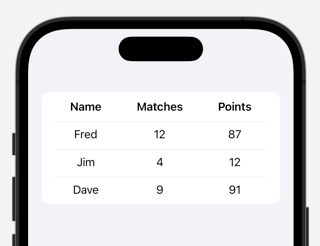I'm working on an app for my local sports league.
One view will be the current standings, with several fields on each row: Name of team, Games Played, Points, etc. I want the Teams column to be left-aligned, the other columns to be right-aligned.
It seems the best answer is SwiftUI's Table(), but on iPhone, it only displays the first column.
I've tried using an HStack{} with Text():
List {
ForEach(selectedStats()) { stats in
HStack {
Text (stats.name)
Spacer()
Text ("\(stats.totalMatches)")
Text ("\(stats.standingsPoints)")
}
}
}
but I'm having difficulty getting the columns to align left or right across multiple lines in the table.
Is there a way to get Tables to work? Or how can I align my columns?
(P. S. I used the tag TableView, because there is no tag specific to Table or SwiftUI-Table. It would be nice if that could be added.)


